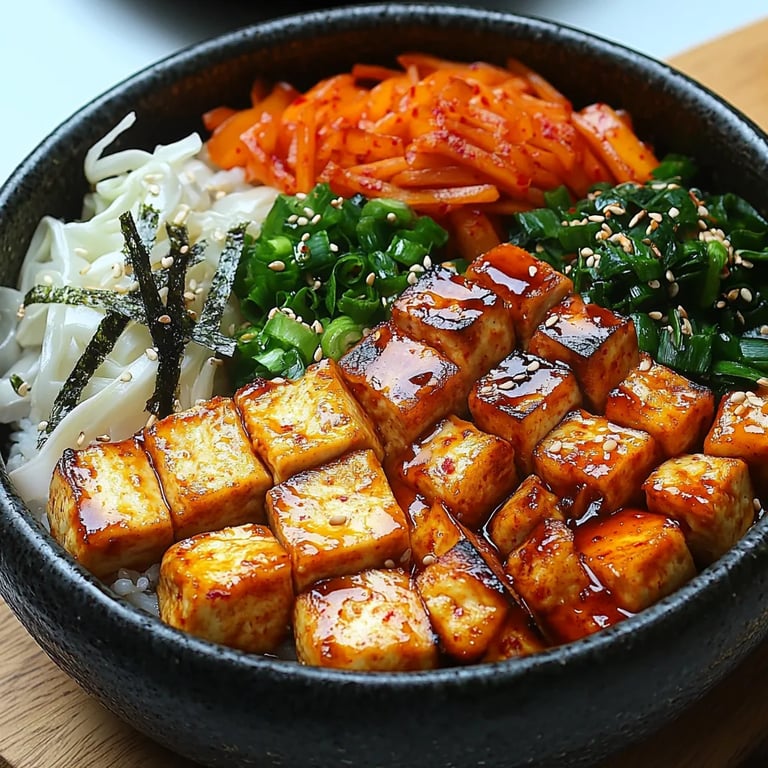Vegan Korean Bibimbap w/ Tofu: An Incredible Ultimate Recipe with 10 Ingredients

Vegan Korean Bibimbap w/ Tofu is the ultimate dish for anyone seeking a vibrant and nutritious meal. This colorful Korean rice bowl is a delightful fusion of flavors and textures. Loaded with vegetables and topped with crispy tofu, it’s a dish that not only tastes amazing but also looks stunning on the plate. If you’ve ever craved a healthy meal that’s both filling and satisfying, look no further.
The name "Bibimbap" translates to "mixed rice," and it originated as a way to use up leftover ingredients. The beauty of this dish lies in its adaptability; you can customize it with your favorite vegetables and tofu seasonings. It's fun to mix everything together just before eating, creating a symphony of flavors that dance on your palate.
Whether you're a long-time vegan or just looking for meatless meal options, this Vegan Korean Bibimbap w/ Tofu is sure to impress. With this guide, you will learn why this recipe stands out, how long it takes to prepare, and the ingredients that make it exceptionally delicious. You’ll be amazed at how simple it is to recreate this iconic Korean dish at home.
Why You’ll Love This Recipe
Vegan Korean Bibimbap w/ Tofu is an extraordinary dish that captures the essence of culinary artistry. Here are some reasons why you’ll fall head over heels for this recipe:
- Colorful Presentation: The vibrant colors of fresh vegetables make this dish visually appealing. It’s like a work of art on your plate!
- Nutrient-Dense: Packed with various vegetables and protein-rich tofu, this dish provides a balanced meal that fuels your body.
- Customizable Ingredients: You can easily tailor the vegetables and toppings based on personal preference or seasonal availability.
- Quick Preparation: With a little prep time, you can have this delicious meal ready in under an hour, making it perfect for weeknight dinners.
- Full of Flavor: The combination of savory soy sauce, sesame oil, and fresh ingredients creates a mouthwatering flavor explosion.
- Suitable for All Diets: Fully vegan and gluten-free options are available, making it accessible to various dietary preferences.
With these enticing aspects in mind, it’s easy to see why Vegan Korean Bibimbap w/ Tofu is often a favorite among family and friends.
Preparation and Cooking Time
Time management is essential for cooking, especially when you're in a hurry. Here’s how long you'll need for Vegan Korean Bibimbap w/ Tofu:
- Preparation Time: 20 minutes
- Cooking Time: 20 minutes
- Total Time: 40 minutes
This timeline makes it feasible for any schedule while still providing a delicious, homemade meal that everyone will appreciate.
Ingredients
- 1 cup uncooked rice (white or brown)
- 1 block (14 oz) firm tofu, pressed and cubed
- 2 tablespoons soy sauce
- 2 tablespoons sesame oil
- 1 cup spinach, chopped
- 1 cup shredded carrots
- 1 cup bean sprouts
- 1 red bell pepper, sliced
- 2 green onions, sliced
- 1 tablespoon gochujang (Korean chili paste) or to taste
Step-by-Step Instructions
Creating Vegan Korean Bibimbap w/ Tofu can be a delightful experience when you follow these straightforward steps:
- Cook the Rice: Start by rinsing the rice under cold water. Cook according to the package instructions—typically, one cup of rice requires two cups of water. Once cooked, set aside.
- Prepare the Tofu: Meanwhile, take the pressed tofu and cube it. Heat a non-stick skillet over medium-high heat. Add one tablespoon of sesame oil, then add the cubed tofu. Cook until crispy, about 5-7 minutes, turning occasionally.
- Flavor the Tofu: Once the tofu is golden brown, pour in two tablespoons of soy sauce. Stir to ensure the tofu is evenly coated, cooking for another 2 minutes. Remove from the skillet and set aside.
- Sauté the Spinach: In the same skillet, add a little more sesame oil if needed. Sauté the chopped spinach until wilted, about 2 minutes. Remove and set aside.
- Prepare the Carrots and Bean Sprouts: Next, cook the shredded carrots and bean sprouts separately in the skillet for about 3-4 minutes until slightly tender but still crunchy. Remove and set aside.
- Cook the Bell Pepper: Add your sliced red bell pepper to the skillet and sauté briefly for about 2-3 minutes until tender. Remove and set aside.
- Assembly Time: In a large bowl, place a portion of cooked rice at the bottom. Arrange the sautéed vegetables (spinach, carrots, bean sprouts, and bell pepper) and crispy tofu on top in a colorful manner.
- Add Gochujang: Top the dish with sliced green onions and a dollop of gochujang to add that spicy kick.
- Drizzle with Extra Sesame Oil: Before serving, consider drizzling a little more sesame oil for richness.
- Mix Together Before Eating: Just before enjoying, mix everything together for a beautifully blended taste of all the ingredients.
By following these steps, you will create a meal that is not only nutritious but also incredibly flavorful!
How to Serve
Serving Vegan Korean Bibimbap w/ Tofu requires some attention to detail for the best experience:
- Bowl Arrangement: Use a deep, wide bowl to ensure all components fit beautifully. Layer the rice first, then add vegetables and tofu in an aesthetically pleasing way.
- Condiments on the Side: Offer additional gochujang and sesame oil at the table for those who want extra spice or flavor.
- Beautiful Garnish: Consider garnishing with sesame seeds or extra green onions for a touch of visual appeal.
- Dining Experience: Encourage your guests to mix their bowls before eating. This not only enhances the flavors but also creates a fun, interactive dining experience.
- Pair with Korean Sides: If desired, serve with traditional Korean sides like kimchi or a simple seaweed salad for a complete meal.
By thinking about presentation and serving style, you can elevate Vegan Korean Bibimbap w/ Tofu from a standard dinner to an extraordinary culinary experience! Enjoy your delightful creation!
Additional Tips
- Prep Ahead: To save time, you can prepare the veggies and tofu ahead of time. Store them in the refrigerator for a couple of days before cooking.
- Explore Different Vegetables: Feel free to experiment with seasonal vegetables. Zucchini, mushrooms, or broccoli can work wonderfully in this dish.
- Adjust Spice Levels: If you're sensitive to spice, start with a small amount of gochujang and add more to taste. Alternatively, you can use sweet gochujang for a milder flavor.
- Cook Tofu to Your Liking: If you prefer softer tofu, reduce cooking time. For extra crunch, let it cook a bit longer until it becomes wonderfully crispy.
- Add Fresh Herbs: Fresh herbs like cilantro or perilla leaves can enhance the dish’s flavors. Sprinkle some on top for a refreshing finish.
Recipe Variation
Feel free to switch things up! Here are some variations to try:
- Quinoa Alternative: Substitute rice with quinoa for a protein boost. Quinoa is packed with nutrients and offers a unique texture.
- Spicy Tofu: Marinate the tofu in gochujang and soy sauce before cooking for a more intense flavor profile.
- Buddha Bowl Style: Create a Buddha bowl by adding other grains like farro or barley, along with additional toppings such as avocado or sesame seeds.
- Create a Cold Bibimbap: Serve the bibimbap cold by letting all components cool and mixing them with a light sesame dressing, perfect for hot days.
Freezing and Storage
- Storage: Leftovers can be stored in airtight containers in the refrigerator for up to 3 days. Reheat gently in the microwave.
- Freezing: You can freeze individual portions of the bibimbap for up to one month. Be sure to pack each serving tightly to avoid freezer burn. For best results, store the rice and veggies separately.
Special Equipment
You will need a few essential tools to prepare Vegan Korean Bibimbap w/ Tofu successfully:
- Non-stick Skillet: For frying tofu and sautéing vegetables without sticking.
- Rice Cooker or Pot: For perfectly cooked rice.
- Sharp Knife and Cutting Board: For prepping vegetables with ease.
- Bowls for Assembly: Wide and deep bowls help keep the ingredients neatly arranged.
Frequently Asked Questions
Can I Use Pre-Cooked Rice?
Yes, using pre-cooked rice can save you time. Just warm it up before assembling your bibimbap.
Is Gochujang Necessary?
While it adds a distinct flavor, you can omit it or substitute with chili flakes or sriracha for a different taste.
Can I Make This Dish Gluten-Free?
Absolutely! Use tamari instead of soy sauce to make this recipe gluten-free.
How Can I Incorporate More Protein?
Consider adding edamame or tempeh alongside tofu for an extra protein boost.
What Can I Use Instead of Tofu?
For a different protein source, try chickpeas or lentils, which can be seasoned similarly to the tofu.
Conclusion
Vegan Korean Bibimbap w/ Tofu is a satisfying and colorful meal that brings the flavors of Korean cuisine right to your kitchen. Its versatility and nutritional profile make it ideal for everyone, whether you're vegan or just looking to add more plant-based meals to your diet. With its variety of textures and vibrant ingredients, it is a dish that excites the palate and nourishes the body. Enjoy making this beautifully crafted rice bowl and share it with family and friends for a delightful culinary experience!
